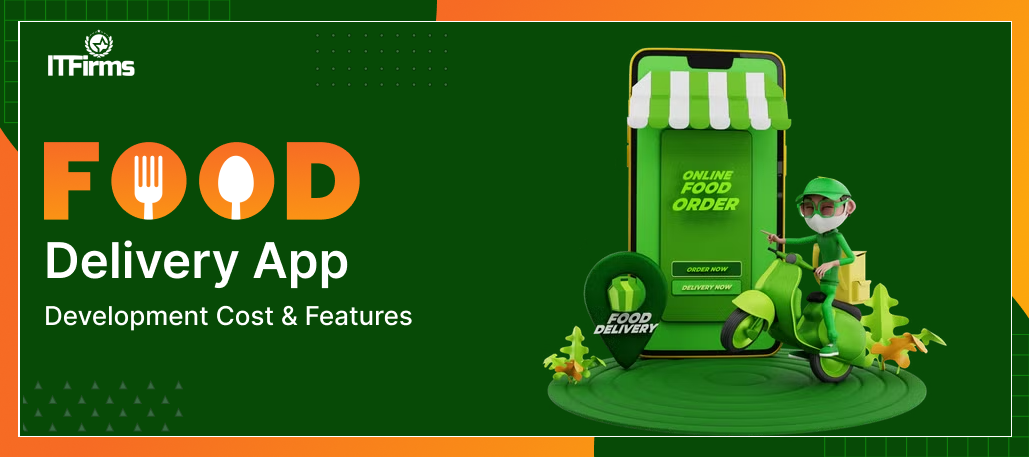
Food Delivery App Development Cost & Features: A Complete Guide
Mobile applications can be molded according to technologies in demand. Know more about trending mobile app frameworks to adopt the latest mobile app development trends here!
Table of Contents
- What is a Food Delivery App?
- Food Delivery App Development & Industry Facts – Top Stats & Numbers
- Top Food Delivery Apps in the Market
- Steps for Food Delivery App Development
- Features of Food Delivery App
- Customer Side Features
- Delivery Driver Side Features
- Restaurant Side Features
- Tech Stack Required for Food Delivery App Development
- Business Model for Food Delivery App
- Monetization Models for Food Delivery Apps
- Top Factors Affecting the Food Delivery App Development Cost
- Total Food Delivery App Development Cost
- The Final Thought
- Food Delivery App Development Cost – Frequently Asked Questions
- How to start a Food Delivery App Business?
- How do food delivery apps earn money?
- How much food delivery app development cost?
The food delivery industry is roaring and has never been in such demand before. For reference, Uber Eats (the leading food delivery app) generated over $4.8 billion (about $15 per person in the US) revenue and currently serves happy meals to 6000+ cities globally. COVID-19 added fire to this trend and the demand for such apps kept increasing. Still, there is a lot of potential and a good idea can make a place for them in the market. However, the real question comes what is the cost to build food delivery app?
To help you out, here is a complete guide on food delivery app development cost, which includes topics like their business models, some industry stats, steps to build, and the factors affecting the cost.
What is a Food Delivery App?
A food delivery app facilitates home door delivery of food items from restaurants, food chains, stores, shops, and even medical stores. A food delivery app can act as an intermediary between the user and a restaurant. However, some apps only work for one business and serve customers from a particular restaurant only, like Dominos.
Food Delivery App Development & Industry Facts – Top Stats & Numbers
- In 2023, the total revenue of online food delivery market is expected to reach $1 trillion.
- China is the top online food delivery market globally with an annual revenue share of $395 million.
- According to a study, over 86% of US citizens have used a food delivery app once in a month.
- Over 58% of users reported to choose convenience to get the food delivered over going-out.
Top Food Delivery Apps in the Market
Uber Eats
Uber launched Uber Eats to get into the food delivery industry and is currently the most popular delivery app. The app provides services in over 6000 cities and 45+ countries, including India, USA, Germany, Portugal, and South Africa. The company earns through a combination of business models such as delivery fee, subscription fee, and transaction charge from restaurants.
The Uber Eats app has a striking rating of 4.8 stars on Apple App Store and 4.4 on Google Play Store. Most of the popular restaurants and fast food chains are available on the app and the company has entered into delivery from grocery stores, drug stores, and pet shops.
DoorDash
DoorDash is available in more than 7000+ cities globally, covering countries like USA, Canada, Japan, Australia, and Germany. The company works widely on subscription based model costing $9.99/month, facilitating free delivery and incentives on every order. However, if you choose not to go with premium, then the company charges 15%-30% on deliveries and 6% on pickup orders.
The company has ventured into other delivery industries along with food delivery such as gas stations, supermarkets, pet stores, bars and drug stores.
GrubHub
GrubHub is a food delivery app for individuals as well as corporate clients. The company has about shocking 20 million active users and is available in 3000+ cities in UK & USA. Notably, the company generated revenue of $1.8 billion in 2020 and has over 10 million active installs on Play Store and about 7 million on Apple Store.
PostMates
PostMates was acquired by Uber Eats in 2020 and was started in 2013 as a food delivery service. The company has now expanded to other domains also such as pharmacy, gas stations, retail stores, as well as Alcohol delivery in some locations. The app’s easy, responsive, and creative UI/UX played an important in its success in a short span. Lastly, the company has an almost similar business model as Uber Eats.
ChowNow
ChowNow acts as an online directory for restaurants that facilitates deliveries and takes no commission. The company offers a unique option of delivery solutions to fast food chains and restaurants. The company has collaborated with 22000+ restaurants that serve nearby areas and is quite popular among rural as well as urban cities. With their new social media integration feature where the user can directly place the order from restaurant’s social media pages.
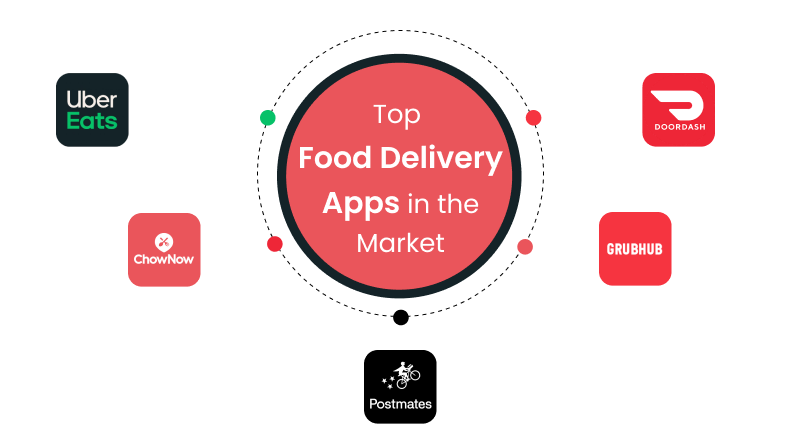
Steps for Food Delivery App Development
Business Model
There are two most popular business models inventory based model and delivery based model. You need to choose one out of them and go with it. Inventory model works best if you have a successful restaurant running already and the later one works as handling delivery from multiple restaurants.
Market Research & Discovery
The continuation of the last step is market research about the industry, market, target audience, and the business model. There are many aspects to a business that contributes to its success and carefully moving keeping them in mind is important. You can also jot down all the features that you want in your app while researching to get a robust app. There are a number of ways to research the functions for your app such as brainstorming, surfing through the internet, or reading the mobile app development guide on the internet.
Hiring a Software Developer
Once you’re done with idea curation, the next step is to hire a top mobile app development services provider. This is a critical step and your business success depends greatly on app’s features, smoothness, and design. Make sure to look for mobile app development companies India with relevant past experience, strong portfolio, and uses latest tools & technologies. The food delivery app development cost for Asian companies is much less than the USA or UK ones.
Development
The next step is to get the app developed by the company we chose. It is critical to be in continuous touch with the team to be updated about the progress. The company will work on Backend to build some top-notch features and the UI/UX will design the app’s frontend. Note that customers form an impression in their minds just by looking at the app design. Thus, consider some top frontend developers to build a great design for your app.
Testing
App testing phase starts after the development phase and all the bugs are identified in this step. The identified bugs & mistakes are then resolved. Note that earlier the testing starts, the easier it is to catch bugs in the code. You can navigate through the app and test important features before making it live to the public.
Features of Food Delivery App
A food delivery app has three major users, i.e. customers, restaurants, and the delivery boys. Note that as you add more features in your, more will be the food delivery app development cost. Below are the features described for each one of them:
Customer Side Features
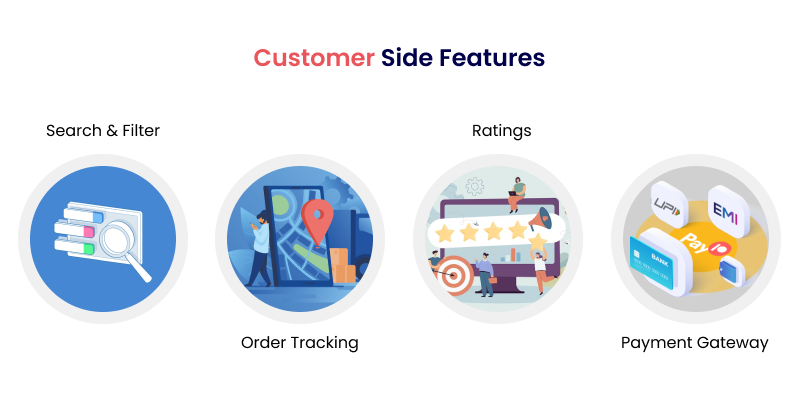
Search & Filter
A food delivery app must have a restaurant & dish search feature for customers. The customers can navigate through and explore the different options they have with this function. Additionally, a filter feature will facilitate to narrow down the search as per the user requirement. Some most common features are sort by, cuisine type, ratings, locations, etc.
Order Tracking
Another feature that helps to build user trust in your food delivery app is tracking orders in real time. Tracking orders by integrating Google maps assures users about their package and lets them know the time remaining in the delivery.
Payment Gateway
It is important to facilitate different payment options for the success of your app. Allow your users to pay for the order through cards, PayPal, UPI, or any other medium. Integrating with third party payment apps is an easy and efficient way.
Ratings
Allowing customers to review and rate the food delivered, restaurants, as well as the app is necessary. It helps in identifying the loopholes of the app and also provides a fair marketplace for restaurants that serve good food.
Delivery Driver Side Features
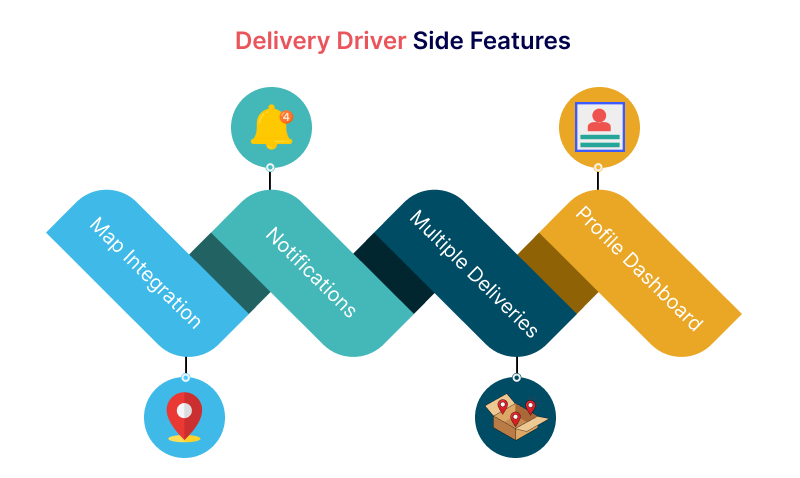
Map Integration
It is utmost important for drivers to reach the location on time and through the shortest route. Thus, it is essential to integrate maps in driver’s panel so that he delivers the last minute food on time.
Notifications
Drivers continuously receive new orders and it is important for them to get notifications about them. They must get push alerts about the next delivery even when the app is not running in the background to keep them aware all the time.
Multiple Deliveries
All the delivery boys should have the option to handle multiple deliveries at a time and answer to possible requests of the nearby areas.
Profile Dashboard
It is important to build a profile dashboard in your app for drivers. It will help keep record of the vital driver information such as photo, name, email ID, residential address, and ID card.
Restaurant Side Features
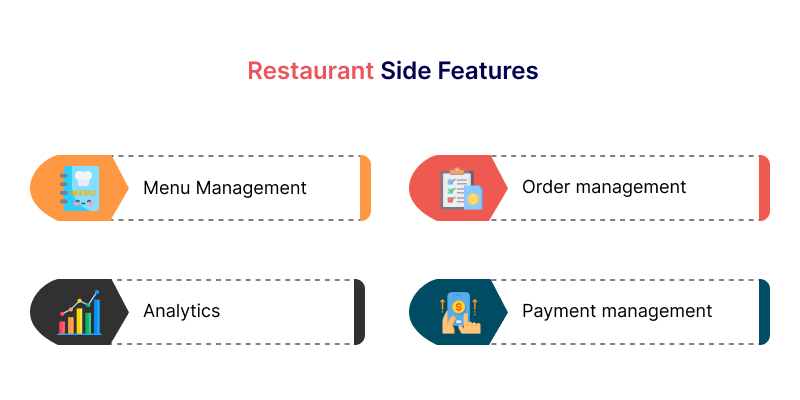
Menu Management
Restaurant owners or authorized persons should be able to edit and manage the menu items and the information in it. You should be able to add, remove a menu item as well as upload pictures, update price, and add description of the dish.
Order Management
A restaurant owner should be able to accept or reject an order. This function helps big restaurants to keep order in line and streamlined.
Analytics
A restaurant owner should be able to track his listing’s performance in the app only. The analytics should include the number of clicks, impressions, and ROI (in case of ad spending)
Payment management
A dedicated payment platform should be built for restaurant owner to manage their cash-in & out. The owner should be able to withdraw the balance to his bank account as well as spend that amount in the ad, if required.
Tech Stack Required for Food Delivery App Development
| Technologies | AWS and VULTR | Laravel | Nginx | MySQL and Redis | Android Studio |
| Function | Hosting | Frameworks | Server | Database | Android IDE |
| Technologies | React and Flutter | Objective-C and Swift | Java and Kotlin | Stripe | XCode |
| Function | Cross-Platform | iOS | Android | Payment Gateway | iOS Toolkit |
Business Model for Food Delivery App
Food delivery apps work majorly on two business models namely –
Aggregator Based Model
Aggregator models acts as a marketplace for restaurants, food chains, shops, and stores and charge them on every transaction. Food delivery apps like Uber Eats & Zomato work on this model. Further, you have the option to provide your own delivery service to the restaurants or on board a third party delivery service provider.
Inventory Based Model
Inventory based model is connecting users to a single food chain or restaurant. This model is suitable for big food chains and established restaurants that want to scale. The owner or the admin controls the operations, delivery, order chain, and preparation. Some top examples that work on this model are McDonalds, Dominos, Burger King, and Subway.
Monetization Models for Food Delivery Apps
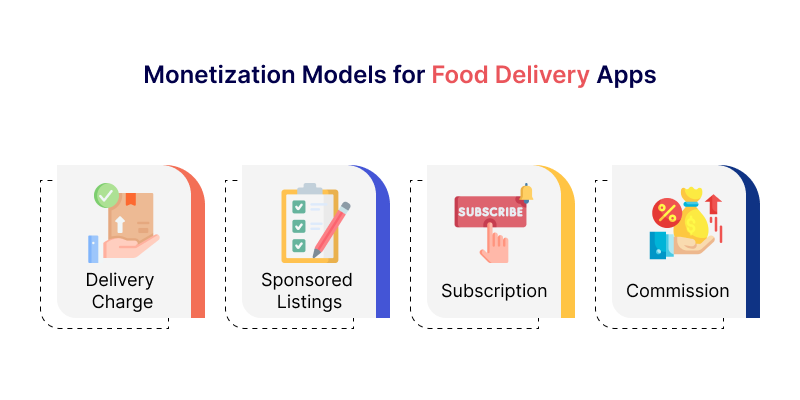
Delivery Charge
Delivery charge rendered by food delivery apps are shared with the drivers but a good part is kept by the company. This is a common revenue generating stream for the companies and the fees depend upon several factors, such as distance, holiday, and timing of the day.
Sponsored Listings
Advertisement revenue from other restaurants to show their listing on top is a great way to monetize the app. Restaurant owners who want to boost their revenue pay the food delivery app to list them on top which in turn increases the revenue. You can also enable Google Ads to generate some revenue.
Subscription
Many food delivery apps are using the subscription based revenue model to earn money. Apps like Zomato, Uber Eats, and Postmates offer subscription to the users and offer benefits like free delivery and extra discount.
Commission
Commissions account for a significant part of food delivery app’s revenue. You can charge commissions on every transaction from restaurants as well as customers. It’ll act as a stable source of income for you.
Top Factors Affecting the Food Delivery App Development Cost
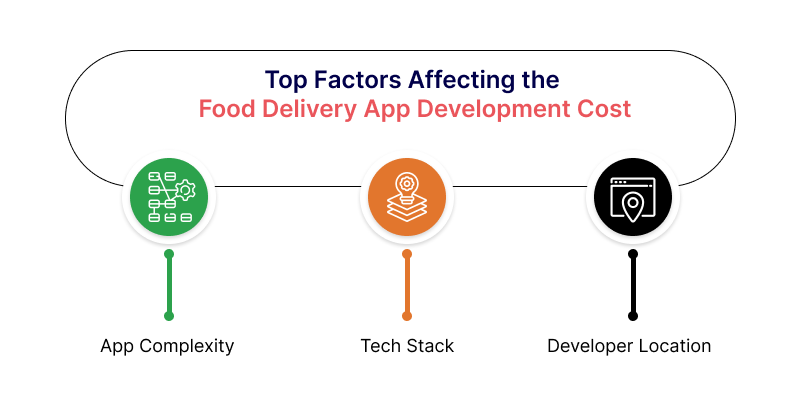
App Complexity
The functions, features, and the complexity you choose for your app largely determines the food delivery app development cost. It is quite clear that more features you want, the more time it takes, and thus, the cost increases.
Developer Location
You might be a little surprised but iOS and android app developers living at different locations charge varied amount for the same skill. For instance, a developer living in North America obviously charges more than the one living in Asian country. The average price of Indian iOS app developers is $20-$50/hourwhile the same for North American developers is $100-$150/hour, thus affecting the total food delivery app development cost.
Tech Stack
Tools, resources, and tech stack required to build your app affects the food delivery app development cost. A food delivery app build for different platforms and operating systems cost more than the one created for one operating system.
Total Food Delivery App Development Cost
The simple formula to calculate the cost to build food delivery app is development time multiplied by per hour price. Now, development time depends upon the complexities, functions, app design, and features we choose. Further, per hour price of the developer is determined by the location and skill required. It takes about 4-6 months to build a food delivery app with some complex features and it might take less for a simpler version.It includes the development of backend, frontend, client panel, driver panel, as well as restaurant panels. However, to give you a rough estimate, the food delivery app development cost is approximately $30,000 – $60,000.
The Final Thought
So this was all about food delivery app development and the cost to build it. Note that the food delivery app is a competitive industry and already have a lot of players in the market. Thus, before you go for the idea, make sure to have some USP or unique feature to make your place among others. It is also important to consider some good cross platform app development companies for a smooth and scalable platform.
Food Delivery App Development Cost – Frequently Asked Questions
How to start a Food Delivery App Business?
You need to identify the gap in the market through market research and discovery phase. Come up with an USP or a unique idea that can make a place in the market. Then build a platform for people to come and start marketing it to the public through digital as well as offline ways.
How do food delivery apps earn money?
Some major sources of income for food delivery apps are commissions, delivery charge, subscriptions, and sponsored listings.
How much food delivery app development cost?
The total cost to build a food delivery app varies and is determined by several factors. These factors include app design, features, time required, tech stack, developer location, etc. However approximately, it costs $20,000 – $50,000 on an average for a delivery app.
